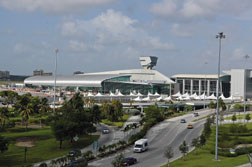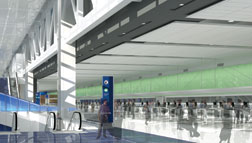
Wayne County Airport Authority Miami Dade International saved $200 million by shutting down its North Terminal during an expansion.
|
“Airports have recovered from 9/11, and the air travel industry is growing. Carriers are increasing fleets and the number of people traveling continues to grow,” says James O. Singer, senior vice president and aviation division manager in Parsons’ Washington, D.C., office. “By the year 2010, there will be a tremendous need for airport capacity.”
According to the Travel Industry Association of America, international travel to the U.S. is expected to rise nearly 4% in 2008, to 55.6 million visitors, following a roughly 5% increase this year. The number of trips that Americans will take in 2008 is expected to climb 2%, to 1.6 billion trips next year, compared to a 2.5% increase in 2007.
|
"Airports have recovered from 9/11, and the air travel industry is growing." —James Singer, senior vice president, Parsons
|
Several airports recently finished or are nearing completion of runway projects. In 2006, Boston’s Logan International Airport opened a new $110-million one-mile-long runway. In 2008, Washington Dulles International Airport is expected to complete a $258-million, 1.8-mile-long fourth runway, and is considering adding a fifth. At the same time, Detroit Metropolitan Wayne County Airport is spending $7 million to rehabilitate a 30-year-old runway and increase capacity on a second.
Runway construction continues at mid-size and smaller airports, fueled by Federal Aviation Administration grants. New runways themselves, coupled with the increase in passenger travel, are sparking an aviation building boom as major airports rehabilitate antiquated terminals and construct new support facilities and infrastructure.
After spending more than $2 billion on its new McNamara Terminal and other improvements, Detroit is now moving forward with its next round of construction projects, which will include replacing its Berry and Smith terminals with a new 26-gate North Terminal complex, expected to open in mid-2008.
“Like many airports, our facilities are 50 years old and were built during a time when the aviation industry was a different animal,” says Jon Hypnar, senior vice president of planning, maintenance and facilities for the Detroit airport. “New technologies, airlines' demands for quick turnaround and other operating efficiencies and security requirements have rendered these older structures obsolete.” Construction projects are occurring at an opportune time for some airports as majority-in-interest agreements, which give signatory airlines the right to review, veto or defer capital improvement projects, are nearing expiration. As a result, a number of airports are considering creating more common-use ticket counters and kiosks, gates and baggage systems.
Hartsfield-Jackson Atlanta International Airport, serving 89 million passengers a year and anticipating 121 million travelers by 2015, is one of several airports finding ways to transform facilities originally geared for single-airline to common-use purposes. Like most metropolitan airports Hartsfield-Jackson has limited real estate, much of which is already committed to a new 1.7-mile runway costing nearly $1.3 billion, a new $835-million international terminal to be finished by early 2011, an $800-million enhancement of its central passenger terminal complex and a new $535-million consolidated rental car facility. The airport already had to acquire additional property to accommodate the runway. Now, to maximize space, Hartsfield-Jackson officials are implementing technology to convert what were once single-airline facilities into common-use areas.
“As exclusive-use agreements end or as we get back baggage claim carousels, gates and other facilities from airlines that have gone through bankruptcy, we are setting [facilities] up as common-use,” says Dan Malloy, assistant general manager for Hartsfield-Jackson. “We are able to maximize space, turn gates faster and get travelers quickly through the ticketing and baggage claim areas.”
Airports also are expanding concourses to add more space for concessions, shops and restaurants. At Miami International Airport, which is involved in a $6.1-billion capital improvement program through 2012, designers created ample room within the $1.1-billion, 1.5-million-sq-ft new South Terminal for 61 concessions.
“Travelers are arriving at the airport earlier to have enough time to get through long ticket and security lines but many are making the decision to arrive even earlier and spend time shopping, working or enjoying a sit-down meal before boarding their flight,” says John Cosper, deputy director for capital improvement at Miami International. Miami airport officials are focused on completing the $2.8-billion, 49-gate North Terminal to allow American Airlines to expand its international service.
|
"The focus has shifted to celebrating the arrival sequence." —Ron Steinert, principal, global aviation dept., Gensler
|
New Focus on Arrival Space
A new trend is surfacing, fueled by advancements in technology: airports are contemplating relocating ticketing and departures to lower floors and moving baggage claim to higher floors. With the ability to check-in at kiosks or obtain boarding passes, and soon baggage tags, from homes and hotels, passengers are spending less time in ticketing areas. The importance is shifting to arrivals where travelers are spending more time waiting for baggage or meeting friends and family.
“There is no need for grand ticketing halls anymore so the focus has shifted to celebrating the arrival sequence,” says Ron Steinert, a principal with Gensler’s global aviation department, Santa Monica, Calif. “Airports are looking at making ticketing a pass-through space on lower levels and raising up the baggage claim area to a higher level, which shows off city views that welcome passengers to their destination.”

Miami-Dade Aviation Department Detroit Metro is launching a new round of projects, which includes a new 26-gate North terminal complex.
|
A Balancing Act
Throughout the duration of these massive projects, airport officials are pressured to find ways to keep commerce and travelers moving by weighing the consequences of closing down facilities against potential cost savings. Airport officials in Miami chose to shut down the airport’s North Terminal and shaved two years off their construction timeline, saving roughly $200 million. “It was a hardship for us to close the terminal but we plan to open gates in the North Terminal in phases, so that will help us ramp up operations quickly,” says Cosper.
Not all airports have that luxury. Since 2001, Dulles has been involved in multiple projects as part of its $3-billion D2 Dulles Development plan, and so far officials have managed to strategically shuttle passengers and planes around the construction without interrupting operations.
viation construction is beginning to rebound from the post-Sept. 11, 2001, air travel downturn and airline bankruptcies after limping along the past few years with only a few large projects, mostly involving security upgrades and new runways. But mid-century terminals and facilities can no longer meet the demands of the growing travel industry, and engineering and design firms say the aviation market is heating up as airports begin to update aging buildings and build new facilities. “One of the significant challenges has been the coordination of construction efforts with airport operations,” says James E. Bennett, Metropolitan Washington Airports Authority president and CEO. “We dedicated an entire staff to coordinate the closures and facilitate communication between the construction side and operation side. It hasn’t been easy rerouting airplanes, baggage vehicles and our mobile lounges but so far we haven’t had any disruptions.”


Post a comment to this article
Report Abusive Comment